|
 Gymnomyces leucocarpus Gymnomyces leucocarpus
BiostatusPresent in region - Indigenous. Endemic
Images (click to enlarge)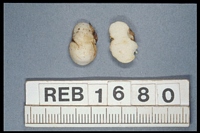
Owner: R.E. Beever | 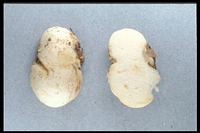
Owner: R.E. Beever | 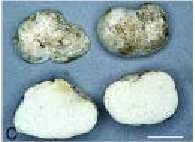
Caption: Fig. 3 C, Gymnomyces
leucocarpus; Scale bar = 10 mm. | 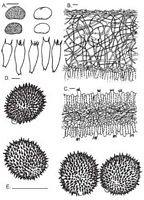
Caption: Fig. 6 Gymnomyces leucocarpus. A, Basidioma; B, peridiopellisand peridial context; C,
hymenophoral trama and hymenium; D, basidia; E, spores. S | 
Caption: Fig. 7 Spores of Gymnomyces leucocarpus. Scale bars = 10 um. | 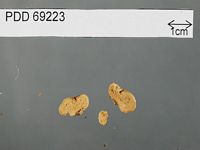
Caption: Dried type specimen
Owner: Herb PDD |
Article: Lebel, T. (2002). Sequestrate Russulales of New Zealand: Gymnomyces and Macowanites. New Zealand Journal of Botany 40(3): 489-509 (http://www.rsnz.org/publish/abstracts.php).
Description: Basidiomata 12-22 x 8-20 mm, subglobose to slightly irregular. Peridial surface dry, smooth,
with some shallow pitting, white. Gleba white to ivory, loculate, chambers minute, crowded,
compacted to appear almost solid. Stipe absent. Columella absent or present as a faint trace of
sterile tissue near base, not percurrent. Odour and taste mild, not distinctive. Latex absent.
Peridiopellis 6-13 µm wide, a thin ixocutis of repent to patchily upright, tightly interwoven,
gelatinised, hyaline hyphal tips 2-5 µm diam. Peridial context 50-90 µm wide, of interwoven,
hyaline hyphae 2-3 µm diam. and scattered, septate, inflated hyphae 3-5.5 µm
diam. Sphaerocysts and endocystidia absent. Hymenophoral trama 10-22 µm wide, of
tightly interwoven, hyaline hyphae 2-4 µm diam. and scattered, inflated hyphae 4-6 µm
diam., sphaerocysts absent. Subhymenium 9-14 µm wide, of branched hyphae with some
inflated cells forming 1-2 tiers of irregular cells 5-8 µm diam. Basidia 25-32 x 10-12 µm,
hyaline, clavate to cylindrical, with 2, 3, and 4 sterigmata 4-7 µm long. Cystidia 25-42 x 8-11
µm, clavate to cylindrical with obtuse apices, hyaline, rare. Spores 7-9 x 7-8.6 µm (8.55 ±
0.34 x 8.1 ± 0.5), Q = 1.03-1.11, globose to subglobose, orthotropic. Ornamentation amyloid,
crowded, of isolated spines ± 1 µm high. Hilar appendix small, hyaline, central; plage present,
inconspicuous, the ornamentation slightly lower around plage. Spore colour in mass white.
Habitat: HABITAT AND DISTRIBUTION: Hypogeous, in small clusters under leaf litter in
Nothofagus menziesii, N. fusca, and N. solandri forests. Fruiting period Aug-Sep.
Notes: ETYMOLOGY: The specific epithet refers to the white basidiomata, from the Greek leuco
meaning white.
NOTES: Gymnomyces leucocarpus can be distinguished from other species of Gymnomyces
in New Zealand by the white peridium (with no hint of other colours), isolated spinose
spore ornamentation, and rarity of the hymenial cystidia.
The abundant ornamentation of isolated spines ±1 µm high of G. leucocarpus is similar to
that of several collections of Gymnomyces and Cystangium from Australia, which are
Eucalyptus associates, and Macowanites rubroluteus, a Nothofagus associate from New
Zealand (Lebel 1998). The Australian collections differ from G. leucocarpus microscopically,
in the structure of the peridiopellis, basidial shape, and more globose spores with
longer spines. The pale yellow peridium with red patches of M. rubroluteus differentiates it
from the white peridium of G. leucocarpus.
|